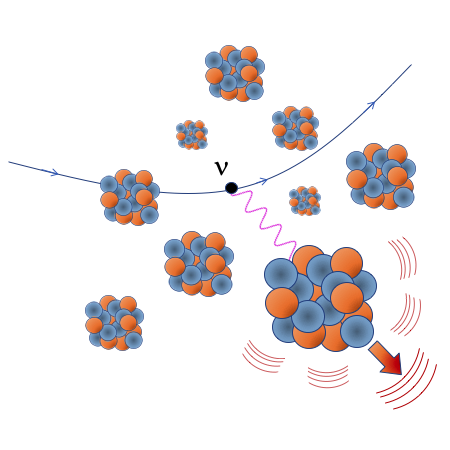CEνNS: Challenges and Opportunities
The process of coherent elastic neutrino-nucleus scattering, CEνNS, is motivated by the very existance of neutral-current neutrino interactions, that allow neutrinos to interact with quarks through the exchange of neutral Z bosons.
For neutrino energies below a few tens of MeV, a long-wavelength Z boson can interact with the nucleus as a whole.
 The occurrence of CEνNS is 2-3 orders of magnitude larger compared to the probability of interacting with the isolated nucleons. Furthermore, compared to other well known neutrino interactions, such as the inverse beta decay, this mechanism does not require neutrinos to have a minimum energy to occur. Nevertheless, CEνNS has evaded any observation for about 40 years since its first theoretical description. From the experimental point of view, indeed, CEνNS can be observed only by measuring the tiny nuclear recoils that it induces. As an example, compared to the aforementioned inverse beta decay, the energy produced by CEνNS is smaller by 4 orders of magnitude.
The occurrence of CEνNS is 2-3 orders of magnitude larger compared to the probability of interacting with the isolated nucleons. Furthermore, compared to other well known neutrino interactions, such as the inverse beta decay, this mechanism does not require neutrinos to have a minimum energy to occur. Nevertheless, CEνNS has evaded any observation for about 40 years since its first theoretical description. From the experimental point of view, indeed, CEνNS can be observed only by measuring the tiny nuclear recoils that it induces. As an example, compared to the aforementioned inverse beta decay, the energy produced by CEνNS is smaller by 4 orders of magnitude.
The first observation of CEνNS was reported by the COHERENT collaboration (2017), which exposed 14.6 kg of sodium-doped CsI scintillating crystals to the neutrino flux produced by a Spallation Neutron Source. Times are now mature to start thinking about high-precision measurements of this process. A measurement performend with an error as low as 1%, indeed, would allow to:
- probe the Standard Model at low energies, for example by measuring with high precision the Weinberg angle at low momentum transfer;
- explore fundamental neutrino properties such as the neutrino magnetic dipole moment;
- search for sterile neutrinos;
- reveal Physics beyond the Standard Model, such as non-standard neutrino interactions;
- support other studies in nuclear physics or supernovae detection;
- offer novel tools for nuclear reactor monitoring.
The increasing interest in a high precision measurement of CEνNS motivated the proposal of the NUCLEUS experiment.